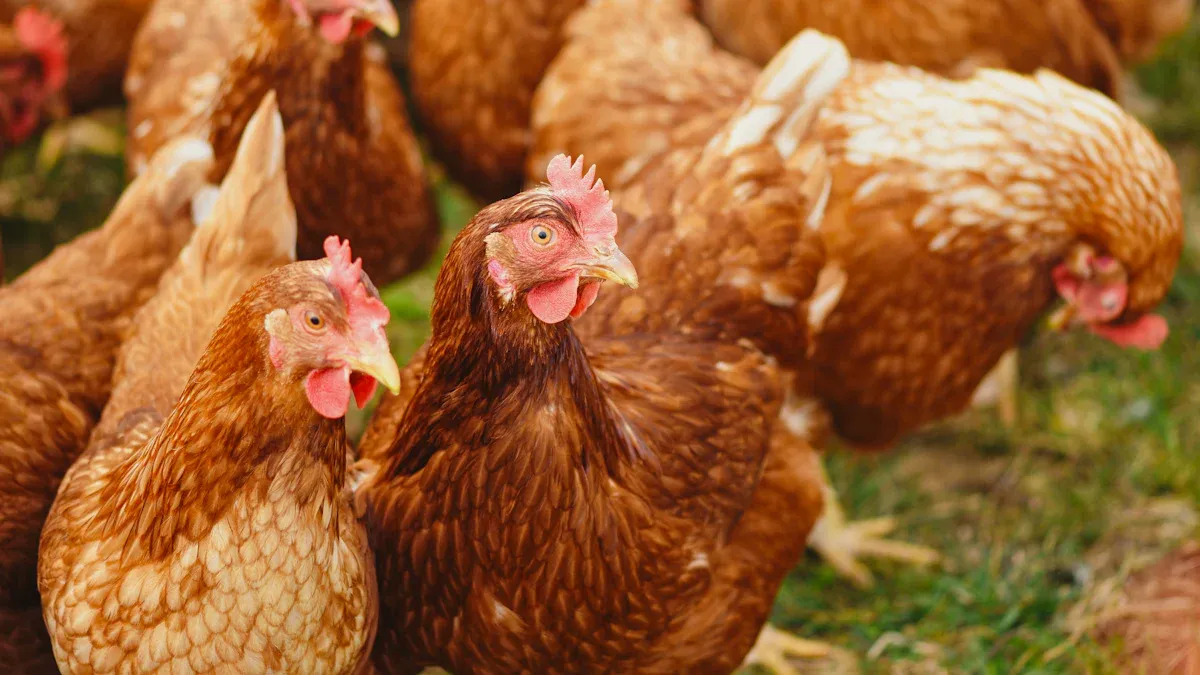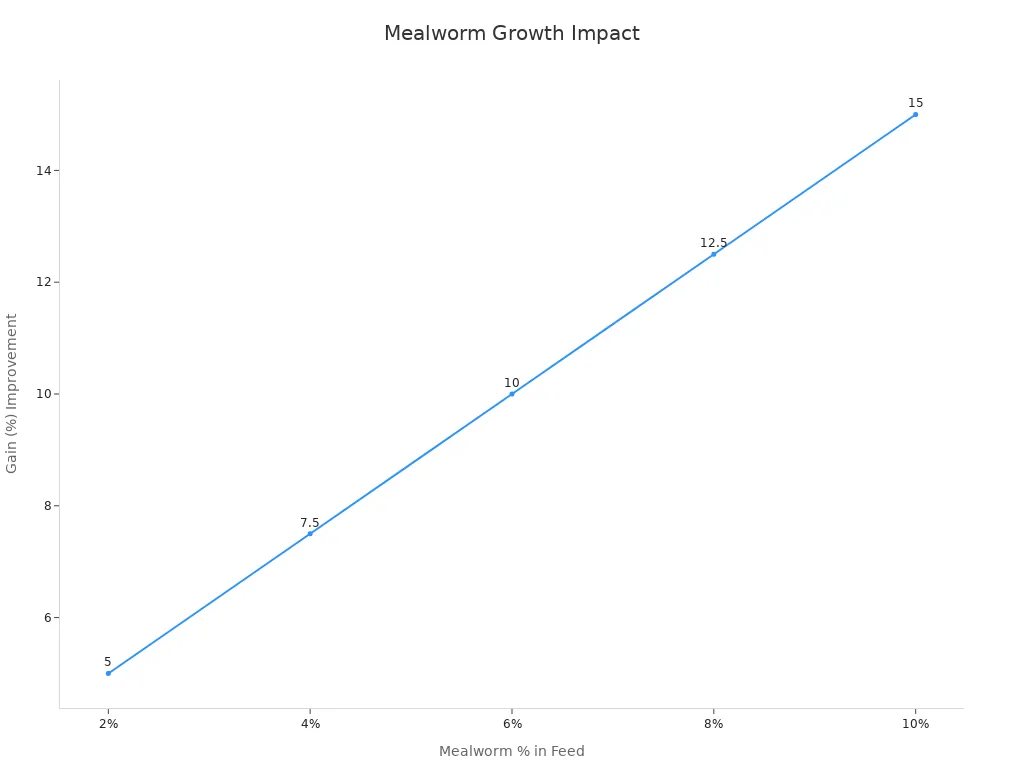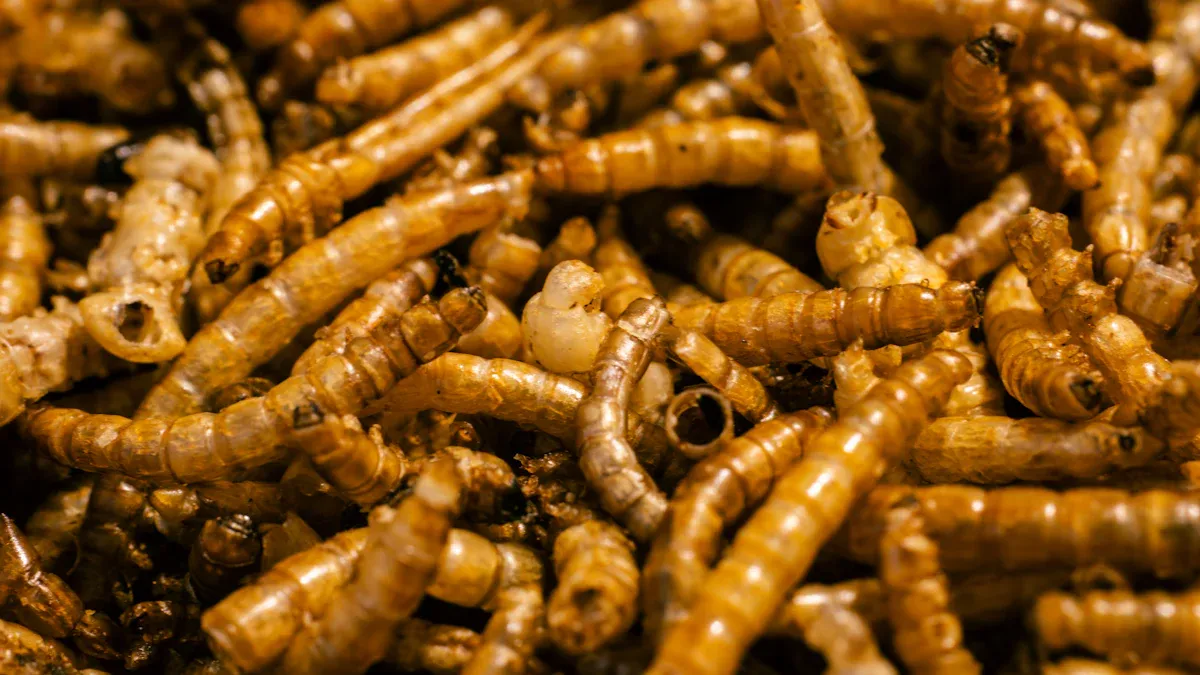
Mealworms in chicken feed turn ordinary hens into feathered dynamos! Packed with protein and healthy fats, these crunchy treats help chickens grow faster and look fluffier. Check out how mealworm meal beats soybean meal in nutrition and growth results:

Key Takeaways
- Mealworms provide high protein, vitamins, and minerals that help chickens grow faster and stay healthy.
- Feeding mealworms improves feather quality, boosts egg production, and strengthens eggshells.
- Using mealworms as a treat supports chicken immunity, encourages natural foraging, and is safe and sustainable when fed in recommended amounts.
Nutritional Science of Mealworms in Chicken Feed

Protein, Vitamins, and Minerals
Chickens love a good snack, but mealworms bring more than just excitement to the coop. These tiny treats pack a punch with their impressive nutritional profile. Farmers and scientists both agree—mealworms in chicken feed deliver a powerful boost of protein, vitamins, and minerals.
Here’s a quick look at what mealworms offer:
| Nutrient/Component | Details/Range |
|---|---|
| Crude Protein (dry matter) | Approximately 45% to 54.4% across various studies |
| Essential Amino Acids | High content; EAAI higher than soybean meal and comparable or higher than fishmeal |
| Fat Content | 15% to 40% |
| Vitamins and Minerals | Present in significant amounts; often supplemented with vitamin and mineral premixes |
| Additional Beneficial Compounds | Chitin, lauric acid, antimicrobial peptides promoting chicken health |
| Protein Quality | Comparable or superior to soybean meal and fishmeal |
| Usage Form | Can be used dried or fresh in poultry diets |
Mealworms in chicken feed can rival or even beat traditional protein sources like soybean meal and fishmeal. For example, Austrian mealworms contain about 53.78% protein, while organic broiler meat sits at 51.5%. Some yellow mealworm larvae even reach up to 71.2% protein, depending on what they eat. That’s a protein party chickens can’t resist!
Chickens also get a healthy dose of vitamins and minerals from mealworms. These nutrients help build strong bones, shiny feathers, and sturdy eggshells. The high protein content supports muscle growth and egg production, making mealworms a favorite among poultry keepers.
Unique Compounds: Chitin and Amino Acids
Mealworms in chicken feed don’t just stop at protein. They bring unique compounds to the table, like chitin and a rich mix of amino acids. Chitin, found in the mealworm’s exoskeleton, acts like a tiny shield for chickens. It boosts their immune system and helps fight off harmful bacteria.
Let’s break down some of the key amino acids found in mealworms:
| Nutrient Component | Documented Range / Description |
|---|---|
| Crude Protein (CP) | 43.3% to 60.2% (average ~52.4%) |
| Lysine | 1.58% to 5.76% |
| Methionine | 0.52% to 2.2% |
| Threonine | 1.57% to 4.29% |
| Tryptophan | 0.02% to 1.86% |
| Arginine | Present, beneficial for growth |
| Chitin | 4.6% to 8.9% of dry matter |
Lysine and methionine are especially important for chickens. They help with growth, feather development, and egg production. Chitin, on the other hand, works behind the scenes. It improves gut health, boosts immunity, and even helps lower cholesterol and triglycerides in chickens. Mealworms also contain antimicrobial peptides, which act like tiny bodyguards, protecting chickens from germs.
Scientific Evidence and Research Findings
Scientists have put mealworms in chicken feed to the test. The results? Chickens grow faster, gain more weight, and use their feed more efficiently. In one study, chickens eating mealworm-enriched diets gained 1423.3 grams, compared to 1322.0 grams for those on a regular diet. Their feed conversion ratio improved too, dropping from 1.88 to 1.75. That means chickens needed less feed to gain more weight—a win for both birds and farmers.
Here’s a quick comparison from a controlled feeding trial:
| Parameter | Control Group | Mealworm Group |
|---|---|---|
| Body Weight Gain (g) | 1322.0 | 1423.3 |
| Feed Conversion Ratio | 1.88 | 1.75 |
| Gross Return (US$) | 0.34 | 0.41 |
Researchers also found that mealworms in chicken feed encourage more activity and foraging. Chickens become more curious and lively, which can lead to better overall health. Farmers around the world are catching on. About two-thirds of small-scale farmers are willing to try mealworms as a protein source, and younger farmers show even more interest.
Tip: Mealworms are not just a treat—they’re a science-backed superfood for chickens!
With all these benefits, it’s no wonder mealworms in chicken feed are gaining popularity. They offer a sustainable, nutritious, and fun way to keep chickens healthy and happy.
Benefits and Best Practices for Mealworms in Chicken Feed
Improved Growth, Feather Health, and Molting Support
Chickens love a good glow-up, and mealworms help them shine. When chickens eat mealworms in chicken feed, they grow faster and look healthier. Farmers notice plumper birds and smoother feathers, especially during molting season. Molting can leave chickens looking a bit scruffy, but extra protein from mealworms helps them bounce back with shiny new feathers.
Check out these numbers from recent studies:
| Parameter | Control Group | Mealworm Group |
|---|---|---|
| Body Weight Gain (g) | 1322.0 | 1423.3 |
| Feed Conversion Ratio | 1.88 | 1.75 |
| Egg Production Increase | N/A | Over 5% more |
Mealworm meal in chicken feed, up to 6%, leads to bigger birds and better daily gains. Feather health also gets a boost, which means less mess in the coop and happier hens. During molting, chickens need extra protein for feather regrowth. Mealworms step in as the perfect snack, helping birds recover faster and look their best.
Tip: Toss a handful of dried mealworms into the run during molting season. Watch your flock perk up and strut their stuff!
Enhanced Egg Production and Egg Quality
Eggs get an upgrade when chickens snack on mealworms. Studies show that hens eating mealworm-enriched feed lay more eggs—over 5% more, to be exact. But the magic doesn’t stop at quantity. The eggs themselves look and taste better.
- Yolk color becomes richer and more golden, thanks to carotenoids in mealworms.
- Eggshells grow stronger and thicker, making them less likely to crack.
- Antioxidants like lutein and β-carotene increase, boosting the nutritional value of each egg.
- Some studies even report heavier eggs and higher laying percentages.
Hens on mealworm diets often produce eggs with a higher yolk proportion and more beneficial nutrients. Farmers see a difference in both the basket and the breakfast table.
Note: Mealworms in chicken feed can turn ordinary eggs into golden treasures—perfect for omelets and sunny-side-ups!
Immune Health, Foraging Behavior, and Enrichment
Mealworms do more than fill bellies—they help chickens stay healthy and happy. The chitin in mealworms supports gut health, which is key for a strong immune system. Chickens with healthy guts fight off germs better and stay active.
Research shows that mealworm inclusion changes the gut microbiota in chickens. While high levels (over 10%) may shift the balance, moderate amounts keep the gut lining strong and the immune system ready for action. Mucin properties in the gut remain positive, forming a sturdy barrier against bad bugs.
Mealworms also bring out the wild side in chickens. When scattered in the bedding, mealworms spark a flurry of scratching and pecking. Chickens become little detectives, hunting for every last morsel. This natural foraging behavior keeps them busy, reduces boredom, and even helps manage the coop’s bedding.
- Early-life enrichment with mealworms sharpens chickens’ foraging skills.
- Chickens show more active behaviors—scratching, pecking, and exploring.
- Flocks with mealworm treats display less feather pecking and more positive social interactions.
- Excitement runs high when mealworms hit the ground, making every feeding time a mini-adventure.
Chickens that forage for mealworms stay sharp, social, and stress-free. Happy chickens lay better eggs and live their best lives!
Feeding Guidelines, Safety, and Sustainability
Mealworms in chicken feed work best as a supplement, not the main course. Experts recommend feeding mealworms as a treat—about 10-15 mealworms per chicken, once or twice a week. During molting, a slight increase helps with feather regrowth.
- Always offer mealworms alongside a balanced diet of grains, seeds, and veggies.
- Dried mealworms are easy to store and keep most of their nutrients.
- Live mealworms add extra excitement and enrichment.
Safety comes first. Studies show that low inclusion rates (2-5%) are safe for both broilers and laying hens. No negative effects on gut health, organ function, or microbiota appear at these levels. Microbial safety matters, so choose mealworms from trusted sources that follow strict processing standards.
Mealworms also score high on sustainability. They convert feed efficiently and use less land and water than traditional livestock. Many producers raise mealworms on food by-products, reducing waste and supporting eco-friendly farming.
Note: For a healthy, happy flock, stick to recommended amounts and always source high-quality mealworms. Your chickens—and the planet—will thank you!
Looking for a convenient way to boost your flock’s health? Try our premium dried mealworms. Packed with protein and essential nutrients, they make the perfect treat for chickens of all ages.
Chickens strut with confidence after a mealworm snack. Their eggs look brighter and shells feel stronger. Flocks show fewer vitamin problems and bounce back faster during molt. Mealworms boost gut health, reduce stress, and spark natural foraging. Happy hens mean tastier breakfasts and lively coops every day!
FAQ
Can chickens eat mealworms every day?
Chickens love mealworms, but they should not eat them daily. Treats work best once or twice a week. Too many mealworms can spoil their balanced diet.
Are dried mealworms as healthy as live ones?
Dried mealworms keep most of their nutrients. Chickens crunch them with joy. Dried mealworms from trusted brands, like our premium product, offer safe, tasty protein.
Do mealworms help chickens during molting?
Yes! Mealworms give chickens extra protein. Feathers grow back faster. Hens strut around looking fabulous. Molting season turns into a feather fashion show.


